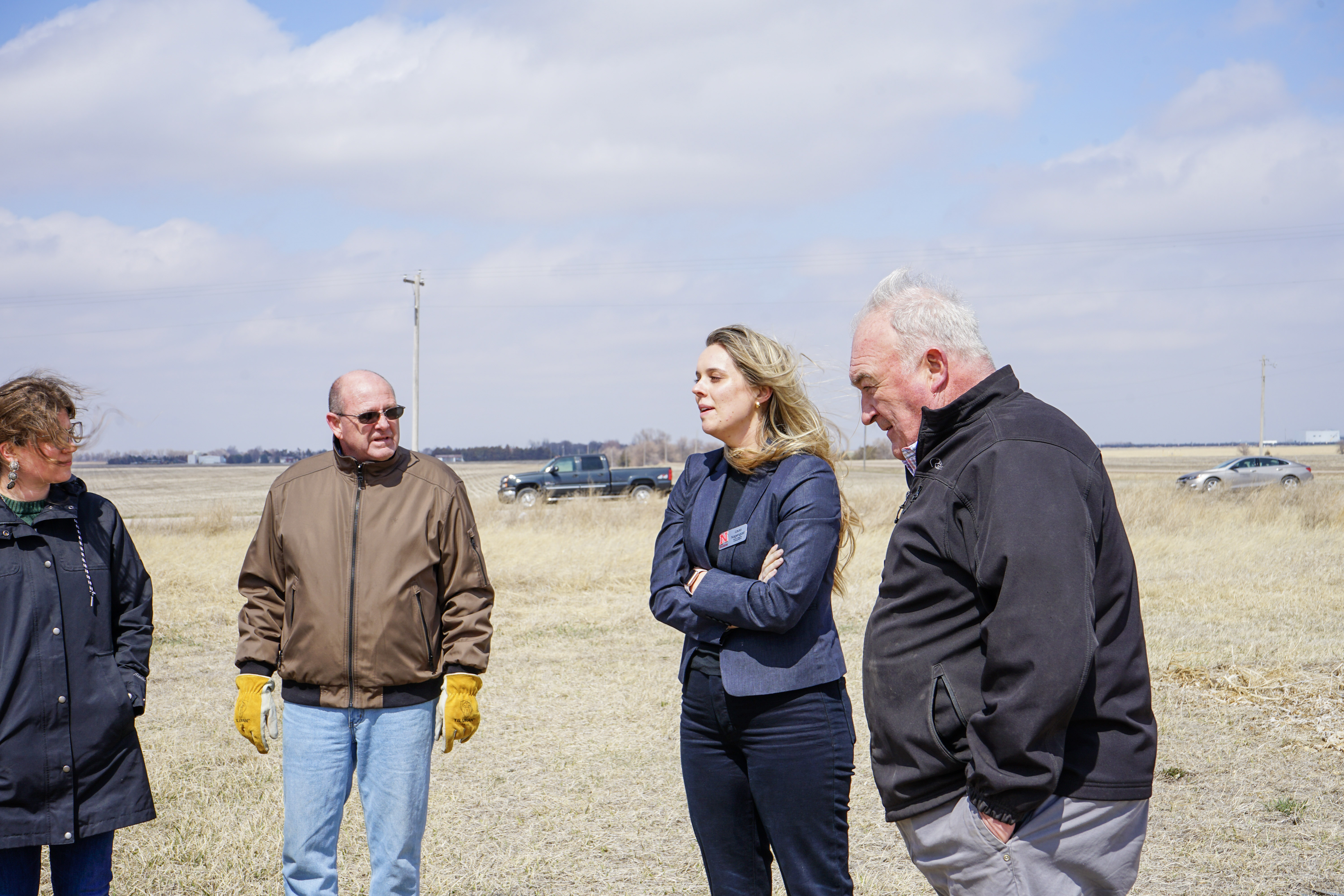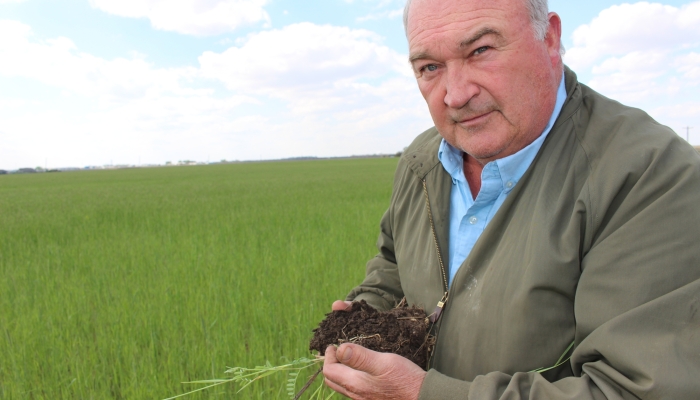Water quality explored at Wellhead Protection Network event
What is the impact of impaired water quality on human health and what can be done about water challenges in the Cornhusker State? These topics and others were addressed at a recent Wellhead Protection Network Meeting held at the Upper Big Blue Natural Resources District (NRD) office in York, Nebraska. Hosted by Nebraska Department of Environment and Energy, University of Nebraska Medical Center, and Nebraska Extension, the meeting drew close to 60 participants from across the state.
The audience was mostly comprised of staff from municipality water departments and other natural resource districts, but the event also drew folks from a variety of agencies and the local agricultural and business communities.
The purpose of the event was to inform those with a stake in water quality issues about strategies and resources available to protect and improve water quality in Nebraska. It was a valuable opportunity for those who manage water resources across the state to network and discuss what challenges they experience in their communities and possible solutions.
"It was great to see a diverse audience that was eager to learn about and discuss water quality issues in our state,” said event organizer Laura Nagengast. “As Nebraskans, we are blessed to have the great water that we do, and it is our responsibility to protect it. Being the first Wellhead Protection Network Event in years, we were thrilled by the attendance.”
The meeting included a series of presentations followed by a tour of the Project GROW demonstration site in York, Nebraska. Since 2017, the City of York and the Upper Big Blue Natural Resources District have worked together to protect water quality in the city’s wellfield through Project GROW (Growing Rotational Crops On Wellfield).
Project GROW highlights how NDEE Source Water Protection grant funding can be used to safeguard a community’s water supply, which in turn provides many additional benefits to the community. The innovative partnership has prioritized restoring the soil in the wellfield as a means of protecting the water consumed by the residents of York. Healthy soil acts as a filtering system that decreases nitrogen leaching and contamination of the drinking water. Project GROW focuses on 160 acres of the total 400-acre wellfield and includes demonstration fields, community garden plots, a fruit orchard, and an extensive pollinator habitat. Using no-till, cover crops, livestock integration, and diverse crop rotations, the project seeks to improve soil health, decrease soil erosion, and improve water holding capacity, all while maintaining profitability.
Wellhead Protection Areas in Nebraska
The Wellhead Protection Network meeting began with a presentation from Erinn Wilkins, water technician at the Upper Big Blue NRD. Erinn discussed the history of the Wellhead Protection Area (WHPA) status in York. The path to the WHPA distinction began in the late 90s in response to high nitrate levels in York’s municipal wells, but a Wellhead Protection Area status and plan were not officially in place in York until 2016.
According to the Environmental Protection Agency, a wellhead protection area is defined as “the surface and subsurface area surrounding a water well or wellfield, supplying a public water system, through which contaminants are reasonably likely to move toward and reach such water well or wellfield.” Nebraska’s Wellhead Protection Program (WHP) is a voluntary program which assists communities and other public water suppliers in preventing contamination of their water supplies. The Nebraska Legislature passed LB 1161 in 1998 authorizing the Wellhead Protection Area Act. This Act sets up a process for public water supply systems to use if they choose to implement a local Wellhead Protection plan. The Nebraska Department of Environment and Energy is the lead agency for Wellhead Protection Plan approval.
The goal of Nebraska’s Wellhead Protection Program is to protect the land and groundwater surrounding public drinking water supply wells from contamination. Since approximately 85 percent of Nebraskans receive their drinking water from groundwater, preventing groundwater contamination is vital.
Wilkins’ presentation on the York WHPA was followed by an overview of Project GROW and the partnership between the Upper Big Blue NRD and the City of York. Dan Leininger, NRD water conservationist, and Brandon Osentowski, water superintendent for the City of York, presented on the unique partnership. The two also discussed the challenges both organizations have addressed in the first five years of the project, from angry calls from area residents after manure application, to paperwork and budget process headaches. Leininger, along with cooperating producer Scott Gonnerman, led the tour of Project GROW later in the day.
Water Quality and Human Health
Extension Educator Laura Nagengast provided an insightful overview of common water quality concerns in Nebraska and their documented links to negative health impacts. A main source of contamination to drinking water in Nebraska is nitrogen fertilizers, commonly used in row crop agriculture practices. The current regulatory limit for nitrate allowed in public water systems is 10 ppm, however private wells are not regulated by any agency. Therefore, it is up to the private well owner to test and treat their own drinking water to ensure what they are consuming is safe. Of special concern in Nebraska is the correlation researchers are seeing between nitrate in drinking water and adverse health impacts on the young, including birth defects and pediatric cancers.
The Upper Big Blue NRD offers free water testing to district residents, either in the NRD lab or via an at-home test. The at-home kits are not as sensitive or comprehensive as having a sample tested in the lab, but they do provide a simple way to determine if additional, more serious, action should be taken, such as installing a reverse osmosis system.
For communities in the Upper Big Blue NRD struggling with water quality, funding is available through the district’s Municipal Water Assistance Program. This program is intended to help communities improve their water system to mitigate the impacts of non-point source groundwater contamination. The end goal of the program is to protect the health of residents in the community.
Funding for qualifying community water system improvements may also be available through the Nebraska Department of Environment and Energy’s Source Water Protection grant program.
Soil Health and the Future of Agriculture
Carolina Cordova, assistant professor and soil health specialist at UNL, also presented at the Wellhead Network Meeting, discussing soil health—what it is, why it is important, how to assess it, and ways to improve it. Cordova touched on how to measure and increase soil organic matter/carbon, which is useful for soil fertility and carbon sequestration that reduces greenhouse gas in the atmosphere. She also presented simple strategies to build and maintain healthy soils including: conservation tillage, organic amendments, and cover cropping. Cordova also pointed to the future of agriculture with greater emphasis on precision agriculture (remote sensing, precision planting and nutrient management, irrigation management technologies) and the economic incentives provided by the burgeoning carbon market.
Producers in the Upper Big Blue NRD as well as the Central Platte NRD have access to additional funding for the soil health practices Cordova touted, as well as access to carbon market incentives, through the Nebraska Soil Carbon Project.
There are additional events in the months ahead on soil health topics available through the UNL College of Agricultural Sciences and Natural Resources, including a soil health and cover crops driving tour in the York area (date TBA). There will also be additional Wellhead Protection Network meetings held at various locations across the state in 2023. Contact Laura Nagengast for more information on these meetings at lnagengast3@unl.edu.


